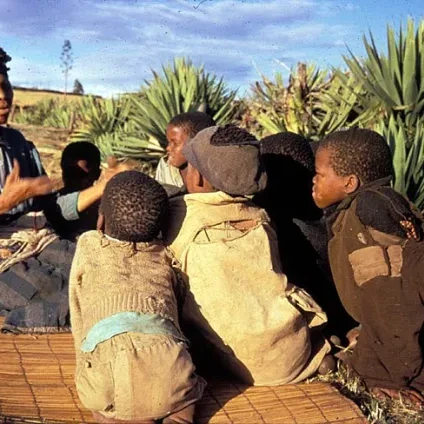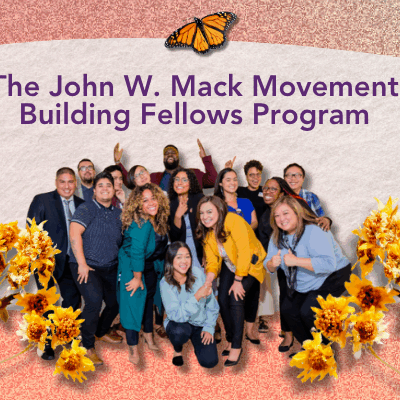PART 1: Juicy Questions about Building Capacity for Racial Justice
If you’re a regular reader or part of Interaction Institute for Social Change’s network, you’ll know that we build collaborative capacity for individuals, organizations, and networks to pursue social justice and racial equity. Organizational and network capacity isn’t the only thing we need to bend the arc of the moral universe toward justice, but there’s no doubt that we need the collective ability to deepen relationships, sharpen analysis, create shared visions, and make space for joy and for rest, even as we design effective strategies and develop action plans.
Last fall, I participated in a panel of grantees of the Borealis REACH (Racial Equity to Accelerate Change) Fund at the Exponent Philanthropy Conference. Moderator Makkah Ali asked us (myself, Judy Lubin of the Center for Urban and Racial Equity, and Natalie Bamdad of Change Elemental) to respond to a series of thought-provoking questions. Our pre-panel dinner and the actual conversation was too juicy not to share! For now, just sit with the questions (some of which were asked directly, and some of which emerged as I was writing this post).
How is racial justice work evolving in organizations and networks?
-
- -What racial equity trends are you noticing in the field?
- -What are people interested in working on? What goals are they focusing on?
- -Where are you finding more resistance?
- -How is the work (i.e., the analysis, goals, methods, language, etc.) evolving as people encounter positive energy and resistance?
- -How are people thinking about the relationship between racism and racial justice and other systems of oppression that matter in their work? What kinds of strategies are they using?
What does it look like to build the capacity of organizations and networks to pursue racial justice?
-
- -Walk us through an engagement that demonstrates what it looks like to make inroads toward racial equity. What were you hired to do? What happened? How did you assess the group’s progress?
- -Walk us through an engagement that demonstrates the barriers or blockades to effectively carrying out racial equity work.
- -What are signs of an organization’s readiness to engage internally in racial equity work?
- -How are we supporting people to stay focused and sustain their efforts over time?
How can funders support their grantees’ racial justice and racial equity work?
-
- -What would you like funders to know about the future of racial equity work and the role they can play in it?
- -What types of support has your organization received that has been most useful to meet this moment?
How can people prepare themselves for this work?
-
- -What does it take from us as practitioners to design and facilitate this kind of work? What kinds of skills, attitudes, and practices do we need to cultivate?
- -What does it take from leaders and staff in organizations? How does that differ for BIPOC folks and white folks? How does it differ for folks from different generations, genders, and other identities?
What other juicy questions are emerging as you work toward racial justice and racial equity?
We will dig into our experiences and responses to these questions in other posts throughout the year. Stay tuned!
PART 2: Lifting Up Emerging Trends
In the first post in this series, we lifted up a set of juicy questions about capacity building for racial justice. Here, we dig into one of those questions: “What trends are you noticing in the field?”
Let’s start with a little good news. In spite of all that conspires to the contrary, we are seeing some positive trends.
People are hungry for effective action. We are seeing a shift in some quarters away from “help us establish agreement on why racial justice and racial equity are important” to “help us build agreement on how we are going to make a real difference.” There is more need than ever for creative thinking and evidence about the effectiveness of efforts. People don’t just want to be busy, they want to move the needle on outcomes that matter within their organizations and within the communities they are serving or organizing.
Racial justice advocates are more paying attention to moving at a human, sustainable pace and nurturing organizational cultures that will support this intention. While the concerns and needs continue to be pressing and urgent, at least some leaders are leaning into practices that put people first and create more spacious, supportive organizational cultures.
Healing and embodiment are finding currency in more spaces. As part of the shift to more sustainable cultures, more people who are advancing racial equity
Some funders are working to shift power dynamics and make their processes more accessible. This includes a revival of interest in general operating support, streamlined paperwork and the emergence of trust-based philanthropy as a framework for shifting power dynamics between funders and grantees.
And, of course, some of the news isn’t so good, and some of that “news” it isn’t even that new.
Burnout is on the rise. Between the trauma of repeated racial violence and mass shootings, the multiple effects of the COVID-19 pandemic, and high vacancy rates in many organizations, both workloads and psychological burdens have risen dramatically in the past few years. Long-time racial justice advocates within organizations and networks are especially weary.
Some organizations are coming apart at the seams and struggling to achieve their missions, in part because of the impact of the effects of systemic racism, power struggles, generational tensions, and gaps in basic management functions. Sometimes there really is an “elephant in the zoom” or “in the room” as Ryan Grim lifted up last summer.
Up is down. False is true. We live in a time where polarization is intensifying and facts seem unimportant to a growing portion of the public and public officials. Public discourse and the public’s ability to think clearly and critically seems to be eroding as race discourse heads in opposite directions at the same time. In the year following the murder of George Flyod, the term “systemic racism” appeared more in the media than it had in the previous 30 years combined. That good news has been met with backlash, as white supremacist and white nationalist rhetoric continues to move from the margins to the mainstream and state legislatures are enacting Orwellian laws to ban books and prevent teaching of a caricature of Critical Race Theory on the grounds that it teaches hate (which it doesn’t) and might make white children uncomfortable (which it might, but has anyone noticed how uncomfortable Black and other children of color feel when their histories are erased or confined to just a few problematic mentions?!).
Among people working for racial equity, the temptation to lump diversity, equity, inclusion, and belonging into a single bucket is leading to frustration and stymying progress. Making diversity a proxy for equity or justice does a disservice to each of these concepts. And it gives cover to those who want to declare victory prematurely (“We have people of color in leadership. We’re all good.”) or who want to point to a lack of progress (“That diversity training didn’t work. So let’s not do any more.”) as a reason to stop pursuing equity and justice at all. Diversity training and efforts to diversify leadership are good things but they will not end systemic racism on their own.
Unclear ideology and analysis leads to muddled thinking and disagreement about what’s needed to make change and what strategies and tactics will get us there. Maurice Mitchell points to this and a host of other challenges to our collective thinking and action as he sheds light on what it takes to build resilient organizations characterized by joy and durable power.
Racism, colonization, and other forms of oppression are baked into the structure of our society and our organizations. Many of our efforts to transform single organizations, systems, or networks run into practices and norms that work against equity and justice. We will not transform the consequences without exposing, uprooting, and replacing the ideology and the practices that hold them in place. This will require new ideologies and new practices that are equal to the task.
In the face of these trends, we have been tailoring the way we work with groups and examining how we operate as an organization. As we enter into a strategic thinking process this year, we will be asking ourselves how we can meet these trends in the field with deepened or transformed ideas, practices, and systems – for our clients and partners as well as for ourselves.
What trends are you seeing as you work for racial justice and racial equity? How are you transforming your ideas, practices, and systems to meet them?

Cynthia Silva Parker is a seasoned capacity builder with more than three decades of experience strengthening organizations and equipping leaders who pursue social justice and racial equity. She finds great joy in the ah-ha moments when people learn a new skill or connect their lived experiences to new ideas. She loves guiding groups to deeper understanding and solid agreements about things that matter. And it’s a great day when she can connect good people to one another and to resources to support their work.
Cynthia has served as a senior associate at the Interaction Institute for Social Change since 1998, delivering facilitation, training, consulting, and coaching services in the nonprofit, public, and philanthropic sectors. She also has led or co-led the development of several IISC workshops, including Advancing Racial Justice in Organizations, the Fundamentals of Facilitation for Racial Justice Work and Collaborative Social Change.
originally published at IISC: Part 1, Part 2
featured image by SpaceX on Unsplash

Network Weaver is dedicated to offering free content to all – in support of equity, justice and transformation for all.
We appreciate your support!



